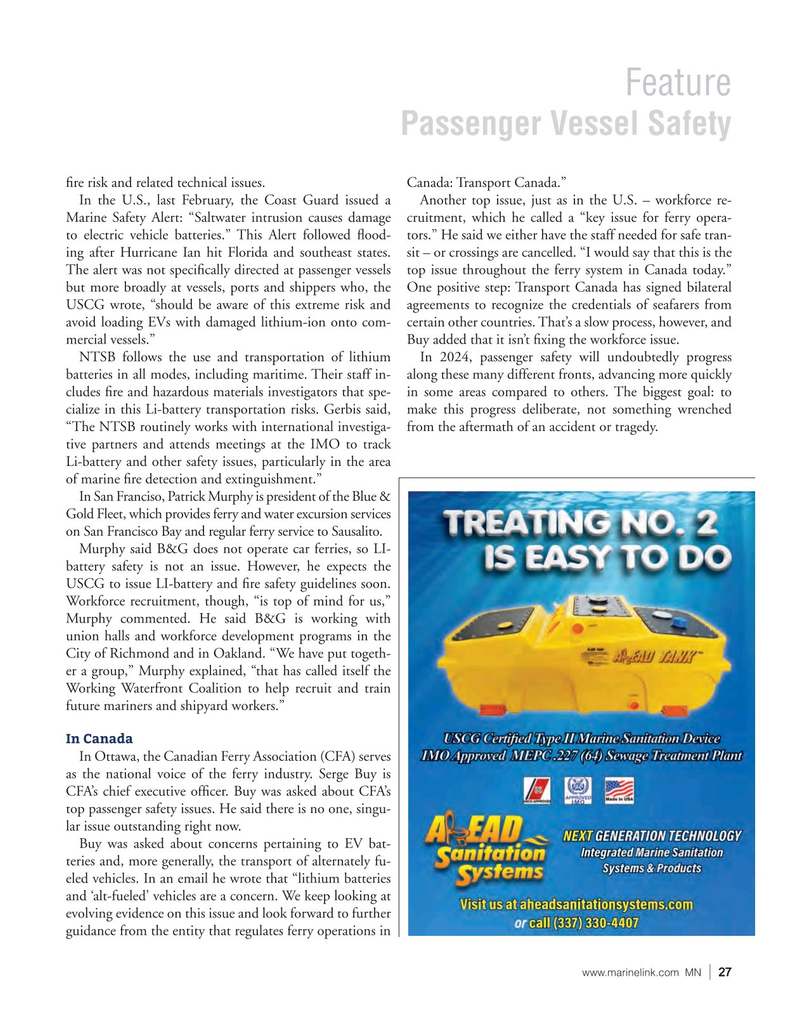
Page 27: of Marine News Magazine (February 2024)
Read this page in Pdf, Flash or Html5 edition of February 2024 Marine News Magazine
Feature
Passenger Vessel Safety ? re risk and related technical issues. Canada: Transport Canada.”
In the U.S., last February, the Coast Guard issued a Another top issue, just as in the U.S. – workforce re-
Marine Safety Alert: “Saltwater intrusion causes damage cruitment, which he called a “key issue for ferry opera- to electric vehicle batteries.” This Alert followed ? ood- tors.” He said we either have the staff needed for safe tran- ing after Hurricane Ian hit Florida and southeast states. sit – or crossings are cancelled. “I would say that this is the
The alert was not speci? cally directed at passenger vessels top issue throughout the ferry system in Canada today.” but more broadly at vessels, ports and shippers who, the One positive step: Transport Canada has signed bilateral
USCG wrote, “should be aware of this extreme risk and agreements to recognize the credentials of seafarers from avoid loading EVs with damaged lithium-ion onto com- certain other countries. That’s a slow process, however, and mercial vessels.” Buy added that it isn’t ? xing the workforce issue.
NTSB follows the use and transportation of lithium In 2024, passenger safety will undoubtedly progress batteries in all modes, including maritime. Their staff in- along these many different fronts, advancing more quickly cludes ? re and hazardous materials investigators that spe- in some areas compared to others. The biggest goal: to cialize in this Li-battery transportation risks. Gerbis said, make this progress deliberate, not something wrenched “The NTSB routinely works with international investiga- from the aftermath of an accident or tragedy.
tive partners and attends meetings at the IMO to track
Li-battery and other safety issues, particularly in the area of marine ? re detection and extinguishment.”
In San Franciso, Patrick Murphy is president of the Blue &
Gold Fleet, which provides ferry and water excursion services on San Francisco Bay and regular ferry service to Sausalito.
Murphy said B&G does not operate car ferries, so LI- battery safety is not an issue. However, he expects the
USCG to issue LI-battery and ? re safety guidelines soon.
Workforce recruitment, though, “is top of mind for us,”
Murphy commented. He said B&G is working with union halls and workforce development programs in the
City of Richmond and in Oakland. “We have put togeth- er a group,” Murphy explained, “that has called itself the
Working Waterfront Coalition to help recruit and train future mariners and shipyard workers.”
In Canada
In Ottawa, the Canadian Ferry Association (CFA) serves as the national voice of the ferry industry. Serge Buy is
CFA’s chief executive of? cer. Buy was asked about CFA’s top passenger safety issues. He said there is no one, singu- lar issue outstanding right now.
Buy was asked about concerns pertaining to EV bat- teries and, more generally, the transport of alternately fu- eled vehicles. In an email he wrote that “lithium batteries and ‘alt-fueled’ vehicles are a concern. We keep looking at evolving evidence on this issue and look forward to further guidance from the entity that regulates ferry operations in www.marinelink.com MN 27|

 26
26

 28
28
